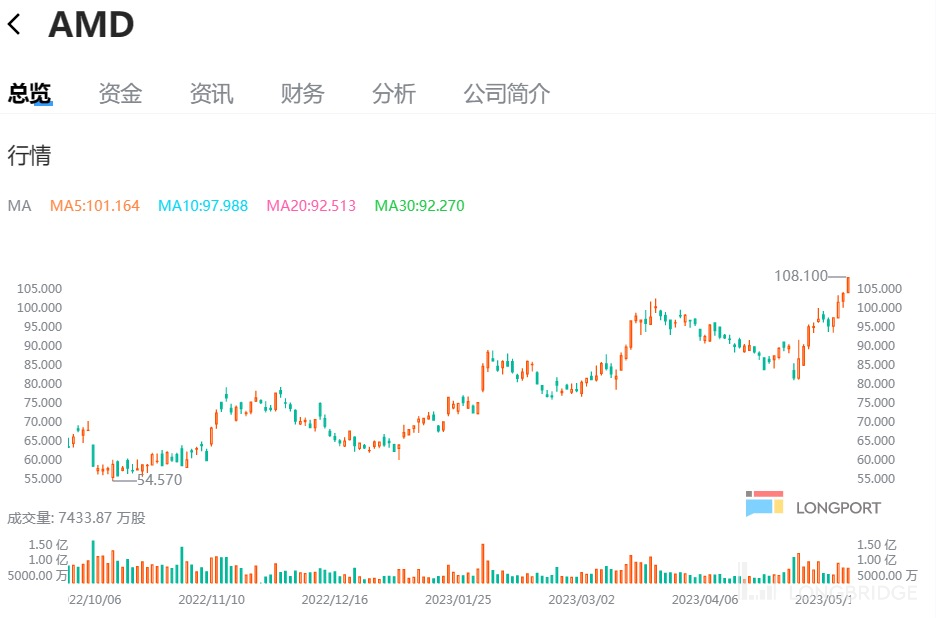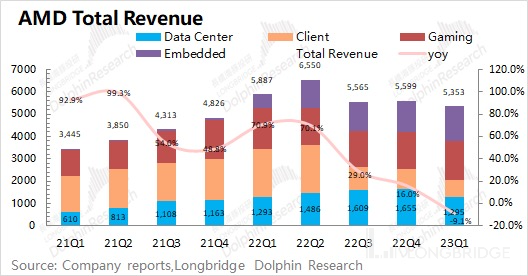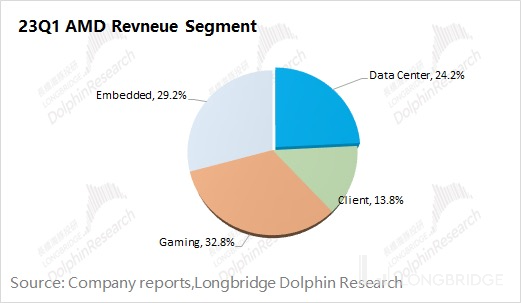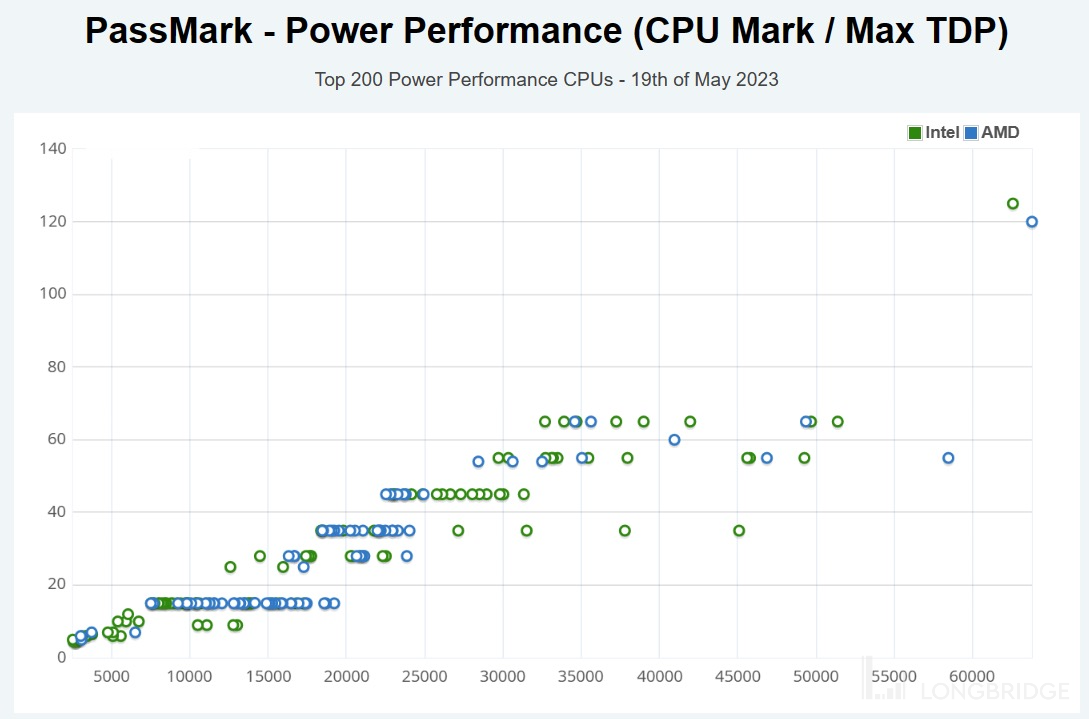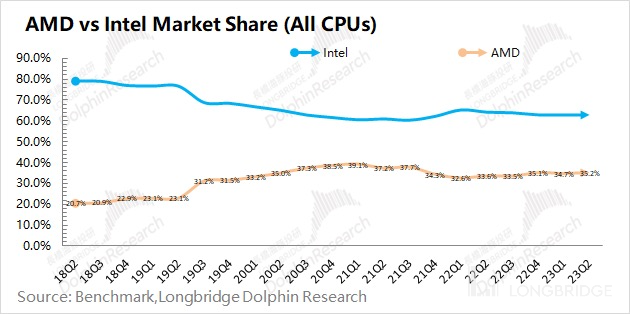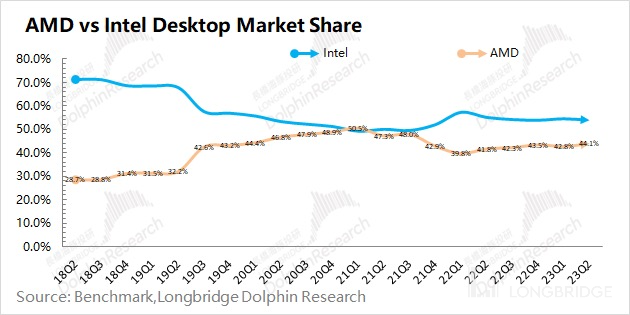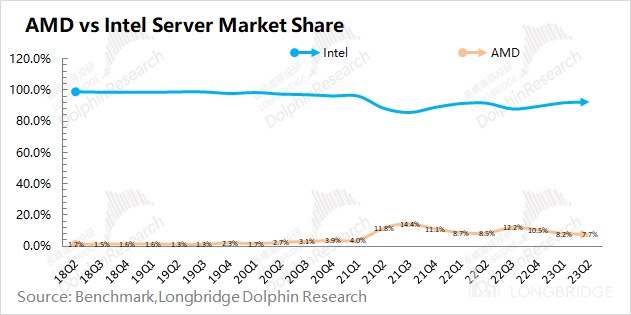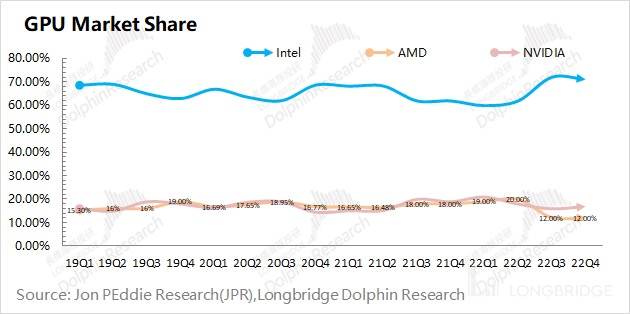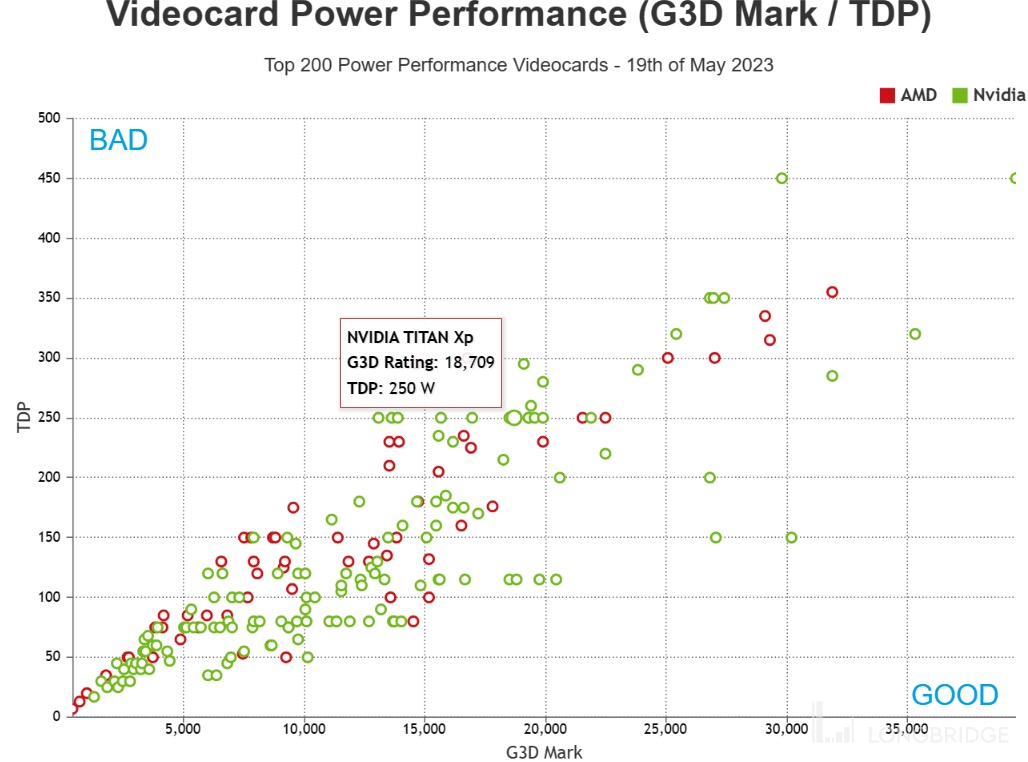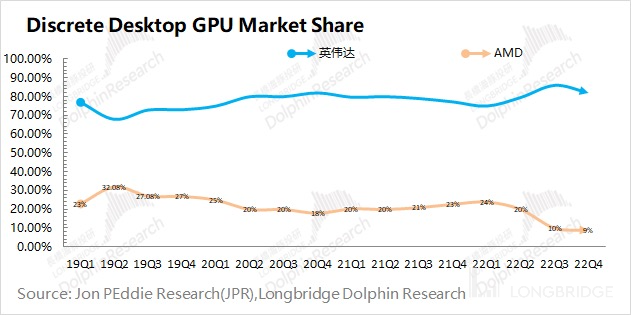
 Likes Received
Likes Received Posts
PostsAMD: Millennial "Runner-up", Can It Make a Comeback?

Compared to Nvidia, which has seen a 200% increase in stock price from the bottom, AMD has just doubled. Both companies are in the business of server chips and computing power. So why is AMD's performance so much worse than Nvidia's? Dolphin Analyst will take a look at AMD with you.

Source: Dolphin Investment Research
Through internal growth and external mergers and acquisitions, AMD has formed three major businesses: "CPU+GPU+embedded". Whether in the CPU or GPU field, AMD has achieved the position of "industry second".
Being able to be in the top two globally naturally indicates strong capabilities. However, "second" has also become another curse for the company. Struggling for decades in the CPU market, it is still second; and in the GPU market, it has also firmly held the second position for more than a decade.
With the experience accumulated in the CPU+GPU field, AMD has set its sights on the data center business. This time, can the company take off the "second" hat in the server market?
For AMD's current business, ①CPU business: it is catching up and constantly eroding Intel's market share, especially in the desktop market; ②GPU business: compared with Nvidia, there is still a gap in technology and market share. Although Intel has also started to enter the discrete graphics card market, there is still a large gap in overall technology compared to the company.
Overall, the company's CPU and discrete graphics card businesses are both in the "second place" in the industry. Due to the embarrassment of being "second", the company also finds it difficult to obtain a large valuation premium. However, in the race for data centers and servers, the industry's development is expected to bring opportunities for the company to grow together.
The following is Dolphin Analyst's specific analysis of AMD:
I. AMD's Business Situation
To analyze AMD, we must first start with the company's business situation. From the latest financial report, AMD's quarterly revenue has grown to more than $5 billion. This is partly due to the company's internal business growth and partly due to its external acquisitions.

Actually, before the rise of servers and graphics cards in this round, the company's revenue for a single quarter remained at 1-2 billion US dollars. Afterwards, benefiting from the increased demand for downstream graphics card and server products, the company's revenue has shown high growth. Subsequently, in the first quarter of 2022, the acquisition of Xilinx was completed, further expanding the company's business scale.
After internal development and external acquisition, AMD's business is mainly divided into four sectors: Data Center, Client, Gaming, and Embedded.
①Data Center: The company includes all server-related revenue in this sector, indicating the company's emphasis on data center business. The current revenue accounts for about 1/4. This mainly includes EPYC server solutions, as well as AMD's own related GPU, FPGA, DPU, SOC and other products;
②Client: This mainly involves PC and notebook products, including Ryzen series CPU solutions, which are all included in this business. This business was originally one of AMD's core businesses, but with the weakness of the PC market, its proportion has fallen to less than 15% this quarter;
③Gaming: This mainly involves gaming-related, high-performance computing and other products, including the company's Radeon series GPU solutions. Independent graphics card and semi-custom graphics card products are all in this business. The gaming business is relatively stable in the company's revenue, with a long-term proportion in the range of 1/4 to 1/3;
④Embedded: The embedded business was originally a very small part of the company's revenue. With the acquisition of Xilinx, part of Xilinx's FPGA business income has also been included in the Embedded business. Currently, this business accounts for more than 20%, mainly from Xilinx's original business.

Overall, although AMD's current business is divided into four parts, the most important part actually comes from three parts, "CPU+GPU+Xilinx". The separate listing of Data Center is mainly due to the company's emphasis on service center business under the current background.
When considering AMD's competitiveness, the market still mainly focuses on the company's CPU and GPU businesses. These two businesses not only have an important impact on the company's performance, but are also the key to the company's continued breakthroughs in the server and other markets. 2. AMD's Two Blades - CPU & GPU
2.1 CPU - The Rise of "Second Child"
CPU business is the foundation of AMD's rise. The company started by being "Intel's little brother". In 1981, AMD obtained the authorization of Intel X86 series processors. Holding onto "Intel's thigh", AMD became the industry's second in the PC era. And this "second in the industry" has been in business for decades.
With the company's continuous technological follow-up and the execution of new strategies brought by Su Ma, AMD's market share in the CPU market has shown a significant increase. AMD's global market share was less than two digits in the past, but now it has grown to more than 30%. The little brother who was once controlled by Intel has begun to threaten the market.
①Technologically: Intel and AMD are the only two mainstream manufacturers in the CPU market. Among them, Intel Core i9-13900KS and AMD Ryzen 9 7950X3D are currently the two best-performing CPUs in terms of running scores, and their overall performance is also very close, with CPU running scores exceeding 60,000 points.

Source: cpubenchmark, Dolphin Research
②Market share: AMD has always been in a follower position in the CPU market. Currently, AMD's market share in the CPU market has risen to 35%. The market share ratio of 9:1 between Intel and AMD in the past can be described as crushing. Now the market share ratio has returned to 2:1, and AMD has brought great pressure to Intel.

In terms of sub-markets, AMD has caught up with Intel in some CPU markets.
1) Desktop market: This is the most traditional competitive market for CPU manufacturers. AMD has caught up with Intel through its own efforts. AMD's share in the latest desktop market has reached more than 40%, while Intel has dropped to around 50%. It has basically caught up with the former king;

2) Server market: With the increasing importance of AI, GC, and cloud in the market, servers are also a major focus of competition. However, the server market was basically monopolized by Intel before. With the launch of AMD EPYC processor products, it gradually gained market recognition. Currently, AMD's market share in the server field has grown from a negligible presence (less than 2% market share) to nearly double digits. With AMD's focus on server and data center businesses, it is expected to gain more market share in the future.

2.2 GPU - Successful Acquisition
AMD originally made its fortune with CPUs and did not delve much into the GPU field. However, the company noticed that the most important components of a PC are the CPU, GPU (graphics card), and storage. Among them, CPU companies have already become the industry's second, and storage companies have tried but believed it was not a profitable business. AMD turned its attention to GPUs.
Based on its 20-30 years of competition experience with Intel, AMD believed that Intel could provide better integration solutions in integrated graphics. The two independent graphics card companies that were of interest at the time were NVIDIA and ATI. AMD then embarked on its most profound acquisition to date.
In 2006, AMD acquired ATI for $5.4 billion, including $4.2 billion in cash and $1.2 billion in stock. ATI became AMD's GPU graphics card division. With this acquisition, AMD successfully entered the independent graphics card market. With ATI's technology and AMD's management, AMD became an important player in the graphics card market.
Although Intel still has the highest market share in the GPU market due to its shipping advantage in integrated graphics, it is difficult to see Intel's presence in the high-end independent graphics card market. It is basically a situation of two strong players, NVIDIA and AMD, competing for dominance.
In other words, although Intel has a leading market share, it mainly occupies the low-end market. The high-end market is left with only NVIDIA and AMD.

In the high-end independent graphics card market, it is difficult to see Intel's presence. There are mainly two players, AMD and NVIDIA:
①Technologically: NVIDIA is still the most advanced in the GPU market, and the company's RTX4090 has even scored 39,000 points in G3D benchmark; AMD follows closely behind, and the Radeon RX7900XTX can also score 31,000 points. Currently, the gap is about one year in terms of benchmark scores;
 来源:videocardbenchmark,Dolphin Analyst
来源:videocardbenchmark,Dolphin Analyst
②Market Share: Nvidia is basically in a leading position in the discrete graphics card market. The main players in the independent graphics card market are Nvidia and AMD, with a market share ratio of roughly 8:2. Recently, Nvidia's market share has remained stable, while AMD's market share has declined somewhat. Intel's Arc A38 discrete graphics product has gained a certain market share, but the overall positioning of the product is entry-level, and the product price is also relatively low. The overall market is currently weak, which has a greater impact on AMD's market share. When the industry rebounds, AMD is also expected to regain its elasticity.
Overall, in terms of technology and market share in the high-end GPU field, AMD has once again taken the "second" position.

Dolphin's research on computing chips and related topics
In-depth analysis of Nvidia
February 28, 2022, "Nvidia: High Growth is Not False, but the Cost-Performance Ratio is Still a Bit Poor"
December 6, 2021, "Nvidia: Valuation Cannot Rely on Imagination Alone"
September 16, 2021, "Nvidia (Part 1): How Did the Chip Giant with a Twentyfold Increase in Five Years Come to Be?"
September 28, 2021, "Nvidia (Part 2): No Longer Driven by Dual Wheels, Will Davis Double Kill?"
Nvidia's Financial Reports and Conference Calls
February 23, 2023, conference call, "Performance Hits Bottom and Will Rebound, AI is the New Focus (Nvidia FY23Q4 Conference Call)"
February 23, 2023, financial report review, "Surviving the Cycle and Meeting ChatGPT Again, Nvidia's Faith Returns"
November 18, 2022, conference call, "Can the Continued Rise in Inventory be Digested in the Next Quarter? (Nvidia FY2023Q3 Conference Call)" On November 18, 2022, Financial Report Review: "NVIDIA: Profit Cut by Two-Thirds, When Will the Turning Point Come?"
On August 25, 2022, Telephone Conference: "How Does Management Explain the Gross Margin of 'Flash Crash'? (NVIDIA FY2023Q2 Telephone Conference)"
On August 27, 2022, Financial Report Review: "Will NVIDIA, Stuck in the Quagmire, Have to Revisit 2018?"
On August 9, 2022, Financial Report Review: "Thunderous Performance, NVIDIA's Performance in Free Fall"
On May 26, 2022, Telephone Conference: "The Combination of Epidemic and Lockdown, Gaming Decline Drags Down Second Quarter Performance (NVIDIA Telephone Conference)"
On May 26, 2022, Financial Report Review: "Without the 'Epidemic Fat', NVIDIA's Performance Looks Miserable"
On February 17, 2022, Telephone Conference: "NVIDIA: Multi-Chip Advancement, Data Center Becomes Company Focus (Telephone Conference Summary)"
On February 17, 2022, Financial Report Review: "NVIDIA: Hidden Worries Behind Better-than-Expected Performance | Reading Financial Reports"
On November 18, 2021, Telephone Conference: "How Does NVIDIA Build the Metaverse? Management: Focus on Omniverse (NVIDIA Telephone Conference)"
On November 18, 2021, Financial Report Review: "With Computing Power and Metaverse Boost, Will NVIDIA Keep Bullish?"
Risk Disclosure and Statement for this article: Dolphin Analyst Disclaimer and General Disclosure.
The copyright of this article belongs to the original author/organization.
The views expressed herein are solely those of the author and do not reflect the stance of the platform. The content is intended for investment reference purposes only and shall not be considered as investment advice. Please contact us if you have any questions or suggestions regarding the content services provided by the platform.

